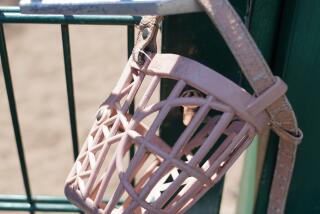Turning the Tide
- Share via
A report released Thursday calls for limiting the number of visitors to the south end of Corona del Mar State Beach, where schoolchildren, tourists and bait-seeking fishermen are contributing to the decline of sea life in the popular tide pools there.
The much-anticipated plan, which also calls for more supervision of visitors, follows research documenting the disappearance of marine animals--including starfish and octopuses--from Orange County’s most heavily trafficked tide pools.
Some Newport Beach City Council members said they will approve the recommendations as early as Monday’s council meeting.
“I want to do whatever makes sense,” said Councilman Gary Adams. “If we need to take measures to support the area, they need to be taken.”
Many of the recommendations could be put in place within weeks, according to report author Tony Melum, deputy chief for the city’s marine and environmental oversight. But a long-term solution could be delayed by murky questions of jurisdiction--and staffing.
Tide pools and marine preserves can fall under the jurisdiction of several agencies, including the city, the county’s Harbors, Beaches and Parks Division, and the California Department of Fish and Game. This can lead to confusion about who enforces ecological regulations, and when.
“We consider Little Corona one of the jewels within the city of Newport Beach,” said Melum. “Our approach is twofold: We’re pressing Fish and Game to step forward, and in the meantime, we’re not letting this slide. It just doesn’t work to say, ‘Hey it’s not my job.’ ”
Recommendations for saving the tide pools are based on field research by local college professors and other consultants. The report has been forwarded to the City Council, and several members said they support the recommendations that include continued research into ways to restore the tide pools, greater involvement by state authorities, and taking steps to better educate the public on the damage that can be done by even the most well-meaning visitors.
Authorities acknowledge that some recommendations might trigger controversy, such as limiting visitors, and determining who will pay for increased staffing.
Lt. Stephen Edinger, of Fish and Game’s Long Beach office, said the agency has four wardens assigned to Orange County, and they are already spread thin. Edinger said, however, that he is committed to finding a solution.
“It is a small tide pool but it’s also critical,” he said. “It’s getting loved to death, so something will have to be done. We cannot give up on it.”
Currently, the tide pools are limited to 300 visitors each day. Melum said the city must consider substantial cuts to that figure, while stepping up enforcement to crack down on people who mishandle or abuse ocean life.
At least six teachers at Newport Beach Elementary School announced last month they are boycotting the tide pools and taking their students to the Long Beach Aquarium instead, a protest they hope underscores their concerns.
At the Orange County Marine Institute in Dana Point, officials applaud the city’s efforts, and predict that educational programs, rather than increased enforcement, will be most effective at saving the area.
“A lot of people don’t even realize the effect they have on the ecological system,” said Rick Baker, director of sea programs there. “If we can get enough people to understand, that is most effective.”
(BEGIN TEXT OF INFOBOX / INFOGRAPHIC)
Pool Protection
Newport Beach City Council members yesterday received recommendations designed to reduce the damage to the Little Corona tide pools. Suggestions range from reducing the number of visitors to increasing staff oversight. The recommendations:
* Reduce number of scheduled daily visitors to a more manageable number
* Prepare new signs to alert the public about harm done by unlawful collecting and impact of foot traffic
* Participate with other agencies, including the California Department of Fish and Game, in protecting the tide pools
* Support continued studies to define causes for the decline in ocean life and identify strategies for restoration
* Increase staffing to include a seasonal tide-pool program supervisor, a marine preserve officer to monitor visitors during low tides, and a coordinator to create and run a volunteer community service group
Source: City of Newport Beach
More to Read
Sign up for The Wild
We’ll help you find the best places to hike, bike and run, as well as the perfect silent spots for meditation and yoga.
You may occasionally receive promotional content from the Los Angeles Times.






